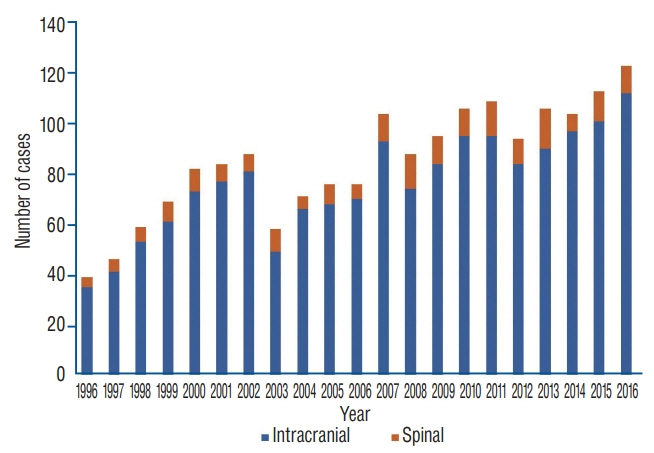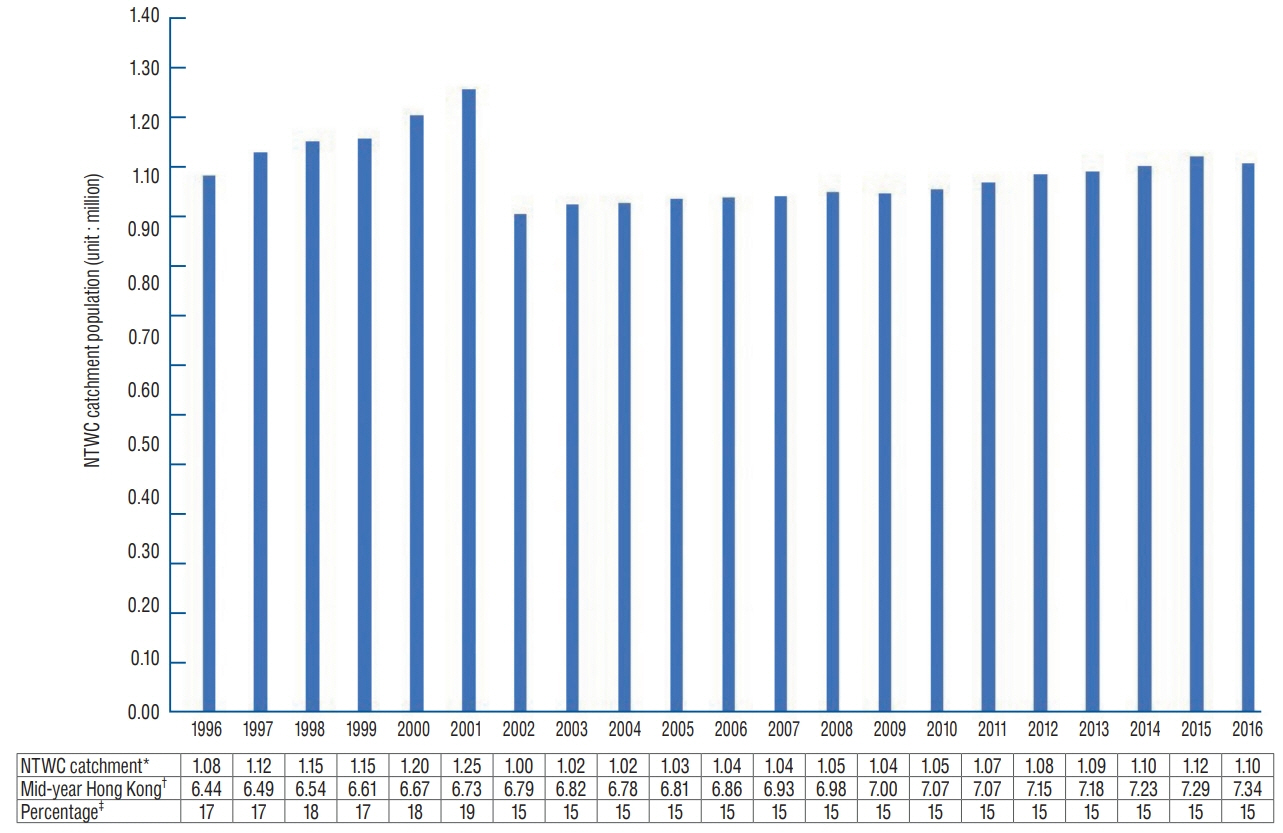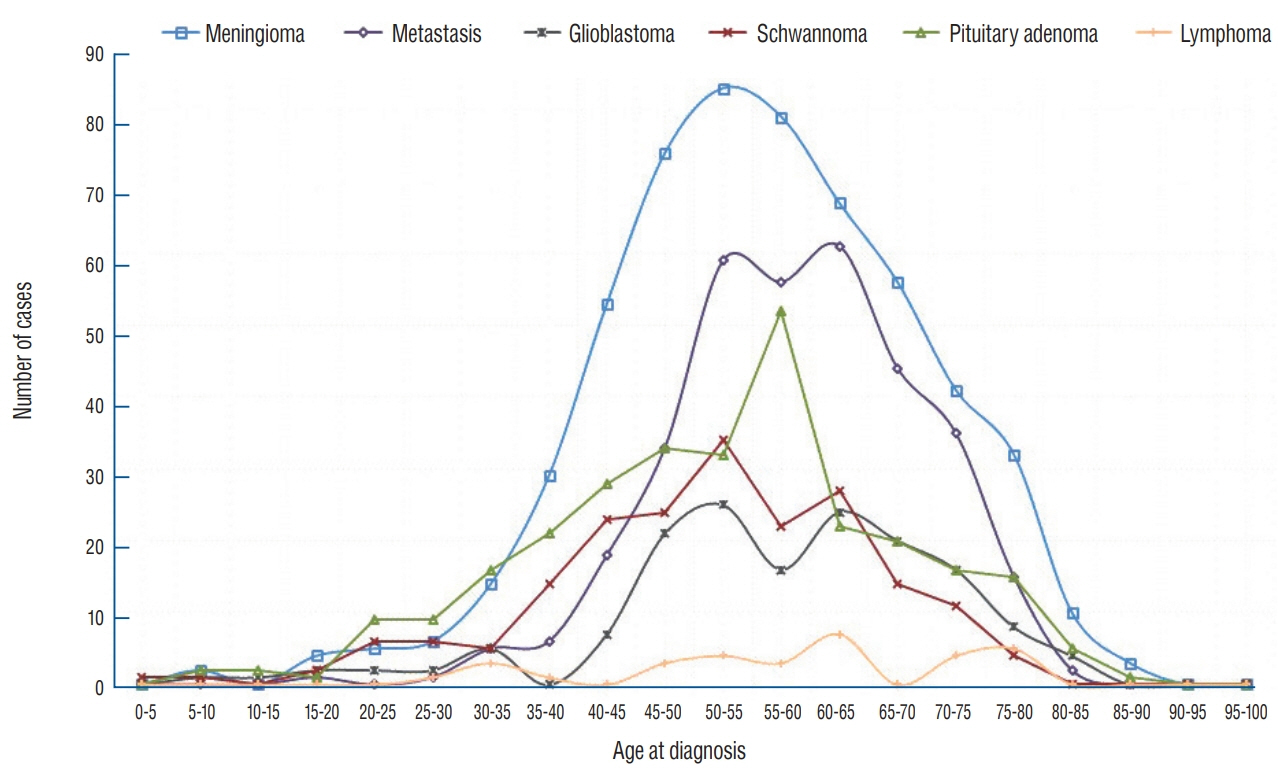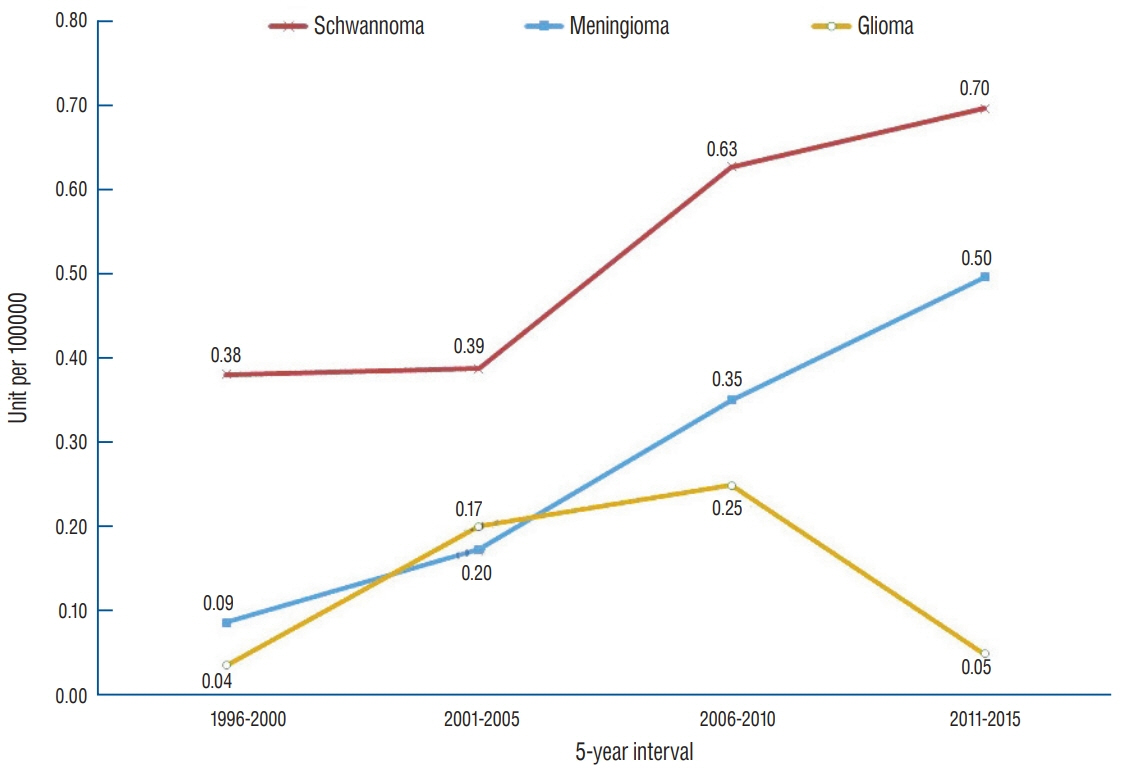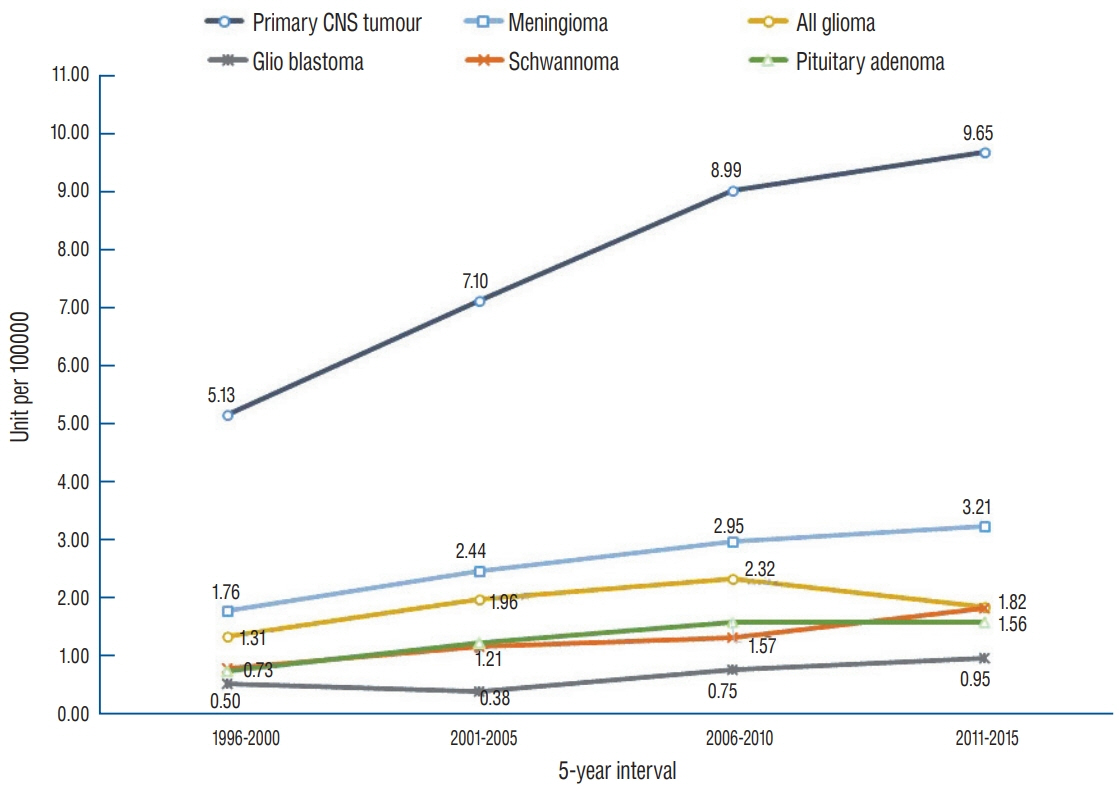J Korean Neurosurg Soc.
2020 Jan;63(1):119-135. 10.3340/jkns.2018.0209.
Newly-Diagnosed, Histologically-Confirmed Central Nervous System Tumours in a Regional Hospital in Hong Kong : An Epidemiological Study of a 21-Year Period
- Affiliations
-
- 1Department of Neurosurgery, Tuen Mun Hospital, Tuen Mun, Hong Kong
- KMID: 2501699
- DOI: http://doi.org/10.3340/jkns.2018.0209
Abstract
Objective
: To investigate the epidemiology of newly-diagnosed, histologically-confirmed (NDHC) central nervous system (CNS) tumours and its changes over a 21-year period in a regional hospital in Hong Kong.
Methods
: This is a single-institute retrospective descriptive study of patients undergoing surgery for CNS tumours in a regional hospital of Hong Kong in the period from January 1996 to December 2016. The histological definition of CNS tumours was according to the World Health Organization classification, while the site definition for case ascertainment of CNS tumours was as set out by the Central Brain Tumour Registry of the United States. Patients of any age, who had NDHC CNS tumours, either primary or secondary, were included. The following parameters of the patients were retrieved : age at diagnosis, gender, tumour location, and histological diagnosis. Population data were obtained from sources provided by the Government of Hong Kong. The incident rate, estimated by the annual number of cases per 100000 population, for each histology grouping was calculated. Statistical analyses, both including and excluding brain metastases, were performed. Statistical analysis was performed with Microsoft Excel, 2016 (Microsoft, Redmond, WA, USA).
Results
: Among the 2134 cases of NDHC CNS tumours, there were 1936 cases of intracranial tumours and 198 cases of spinal tumours. The annual number of cases per 100000 population of combined primary intracranial and spinal CNS tumours was 3.6 in 1996, and 11.1 in 2016. Comparing the 5-year average annual number of cases per 100000 population of primary CNS tumours from the period 1996–2000 to 2011–2015, there was an 88% increase, which represent an increase in the absolute number of cases by 4.52 cases/100000 population. This increase was mainly contributed by benign histologies. In the aforementioned periods, meningiomas increased by 1.45 cases/100000 population; schwannomas by 1.05 cases/100000 population, and pituitary adenomas by 0.91 cases/100000 population. While gliomas had a fluctuating 5-year average annual number of cases per 100000 population, it only had an absolute increase of 0.51 cases/100000 population between the 2 periods, which was mainly accounted for by the change in glioblastomas.
Conclusion
: This retrospective study of CNS tumour epidemiology revealed increasing trends in the incidences of several common CNS tumour histologies in Hong Kong, which agrees with the findings in large-scale studies in Korea and the United States. It is important for different geographic locations to establish their own CNS tumour registry with well-defined and structured data collection and analysis system to meet the international standards.
Keyword
Figure
Cited by 1 articles
-
The Optimal Time between Embolization and Surgery for Hypervascular Spinal Metastatic Tumors : A Systematic Review and Meta-Analysis
Woon Tak Yuh, Junghoon Han, Chang-Hyun Lee, Chi Heon Kim, Hyun-Seung Kang, Chun Kee Chung
J Korean Neurosurg Soc. 2023;66(4):438-445. doi: 10.3340/jkns.2022.0204.
Reference
-
References
1. Census and Statistics Department of Hong Kong. Hong Kong 2011 Population Census - Summary Results. Hong Kong: Census And Statistics Department of Hong Kong;2012.2. Census and Statistics Department of Hong Kong. Hong Kong 2001 population census main report, Vols. I & II. Hong Kong: Census And Statistics Department of Hong Kong;2012.3. Census and Statistics Department of Hong Kong. Hong Kong 2006 population by-census main report: volume I. Hong Kong: Census And Statistics Department of Hong Kong;2007.4. Census and Statistics Department of Hong Kong. Hong Kong 2016 Population By-Census - Main Results. Hong Kong: Census And Statistics Department of Hong Kong;2017.5. Census and Statistics Department of Hong Kong. Population and household statistics analysed by district council district - 2001. Hong Kong: Census And Statistics Department of Hong Kong;2002.6. Census and Statistics Department of Hong Kong. Population and household statistics analysed by district council district - 2003. Hong Kong: Census And Statistics Department of Hong Kong;2003.7. Census and Statistics Department of Hong Kong. Population and household statistics analysed by district council district - 2010. Hong Kong: Census And Statistics Department of Hong Kong;2011.8. Census and Statistics Department of Hong Kong. Population and household statistics analysed by district council district - 2016. Hong Kong: Census And Statistics Department of Hong Kong;2017.9. Census and Statistics Department, Hong Kong Special Administrative Region. Hong Kong monthly digest of statistic. Hong Kong: Census and Statistics Department, Hong Kong Special Administrative Region;2016.10. Census and Statistics Department, Hong Kong Special Administrative Region. Hong Kong monthly digest of statistic. Hong Kong: Census and Statistics Department, Hong Kong Special Administrative Region;2017.11. Dho YS, Jung KW, Ha J, Seo Y, Park CK, Won YJ, et al. An updated nationwide epidemiology of primary brain tumors in Republic of Korea, 2013. Brain Tumor Res Treat. 5:16–23. 2017.
Article12. Ho-Cheong H. Intracranial tumours among Chinese in Hong Kong. Surg Neurol. 12:317–318. 1979.13. Hospital Authority. Hospital Authority Statistical Report (2016-2017). Hong Kong: Hospital Authority;2018.14. Hong Kong Cancer Registry. Hong Kong Cancer Statistics. Hong Kong: Hong Kong Cancer Registry;2015.15. Hong Kong Cancer Registry. Overview of Hong Kong Cancer Statistics of 2016. Hong Kong: Hong Kong Cancer Registry;2018.16. Jung KW, Ha J, Lee SH, Won YJ, Yoo H. An updated nationwide epidemiology of primary brain tumors in republic of Korea. Brain Tumor Res Treat. 1:16–23. 2013.
Article17. Lee CH, Jung KW, Yoo H, Park S, Lee SH. Epidemiology of primary brain and central nervous system tumors in Korea. J Korean Neurosurg Soc. 48:145–152. 2010.
Article18. Louis DN, Ohgaki H, Wiestler OD, Cavenee WK, Burger PC, Jouvet A, et al. The 2007 WHO classification of tumours of the central nervous system. Acta Neuropathol. 114:97–109. 2007.
Article19. Louis DN, Perry A, Reifenberger G, von Deimling A, Figarella-Branger D, Cavenee WK, et al. The 2016 World Health Organization classification of tumors of the central nervous system: a summary. Acta Neuropathol. 131:803–820. 2016.
Article20. Ng HK, Poon WS, South JR, Lee JC. Tumours of the central nervous system in Chinese in Hong Kong: a histological review. Aust N Z J Surg. 58:573–578. 1988.
Article21. Ostrom QT, Gittleman H, Farah P, Ondracek A, Chen Y, Wolinsky Y, et al. CBTRUS statistical report: primary brain and central nervous system tumors diagnosed in the United States in 2006-2010. Neuro Oncol. 15 Suppl 2:ii1–ii56. 2013.
Article22. Ostrom QT, Gittleman H, Fulop J, Liu M, Blanda R, Kromer C, et al. CBTRUS statistical report: primary brain and central nervous system tumors diagnosed in the United States in 2008-2012. Neuro Oncol. 17 Suppl 4:iv1–iv62. 2015.
Article23. Ostrom QT, Gittleman H, Liao P, Rouse C, Chen Y, Dowling J, et al. CBTRUS statistical report: primary brain and central nervous system tumors diagnosed in the United States in 2007-2011. Neuro Oncol. 16 Suppl 4:iv1–iv63. 2014.
Article24. Ostrom QT, Gittleman H, Liao P, Vecchione-Koval T, Wolinsky Y, Kruchko C, et al. CBTRUS statistical report: primary brain and other central nervous system tumors diagnosed in the United States in 2010-2014. Neuro Oncol. 19(suppl_5):v1–v88. 2017.
Article25. Ostrom QT, Gittleman H, Xu J, Kromer C, Wolinsky Y, Kruchko C, et al. CBTRUS statistical report: primary brain and other central nervous system tumors diagnosed in the United States in 2009-2013. Neuro Oncol. 18(suppl_5):v1–v75. 2016.
Article26. Pu JK, Ng GK, Leung GK, Wong CK. One-year review of the incidence of brain tumours in Hong Kong Chinese patients as part of the Hong Kong brain and spinal tumours registry. Surgical Practice. 16:133–136. 2012.
Article27. Wen HL, Cheung SY. Incidence of tumors in the nervous system in Hong Kong. J International surgery. 58:555–556. 1973.28. Zülch KJ. Histological typing of tumours of the central nervous system. Geneva: World Health Organization;1979.
- Full Text Links
- Actions
-
Cited
- CITED
-
- Close
- Share
- Similar articles
-
- The Teratoma of the Central Nervous System
- A Study on CSF Enzyme Activity in Central Nervous System Infections
- Where is the Lesion? Glomus Tumours of the Hand
- Optimizing genicular nerve chemical ablation
- The value of computerized axial tomography of the brain in children with central nervous system disorders

